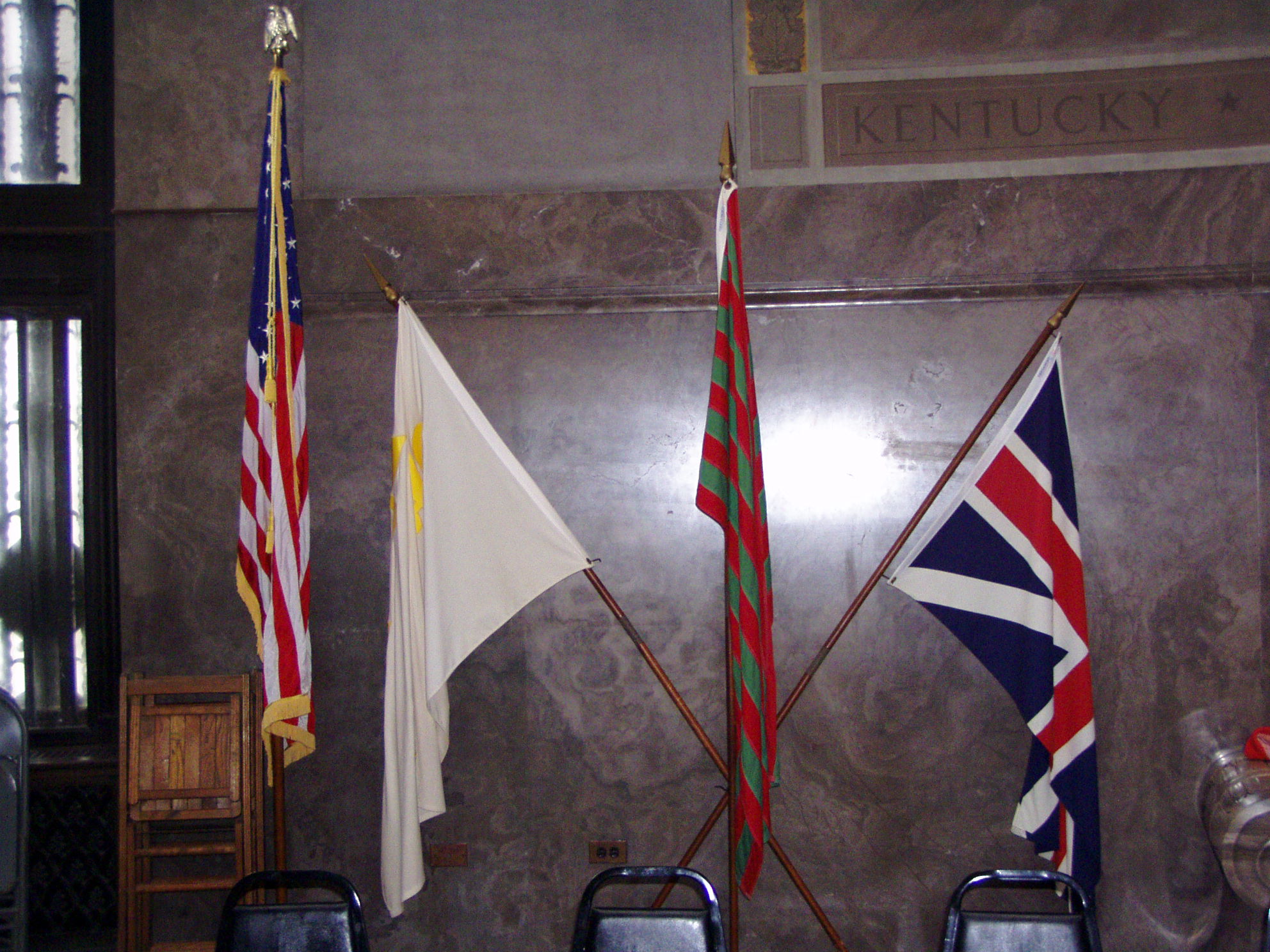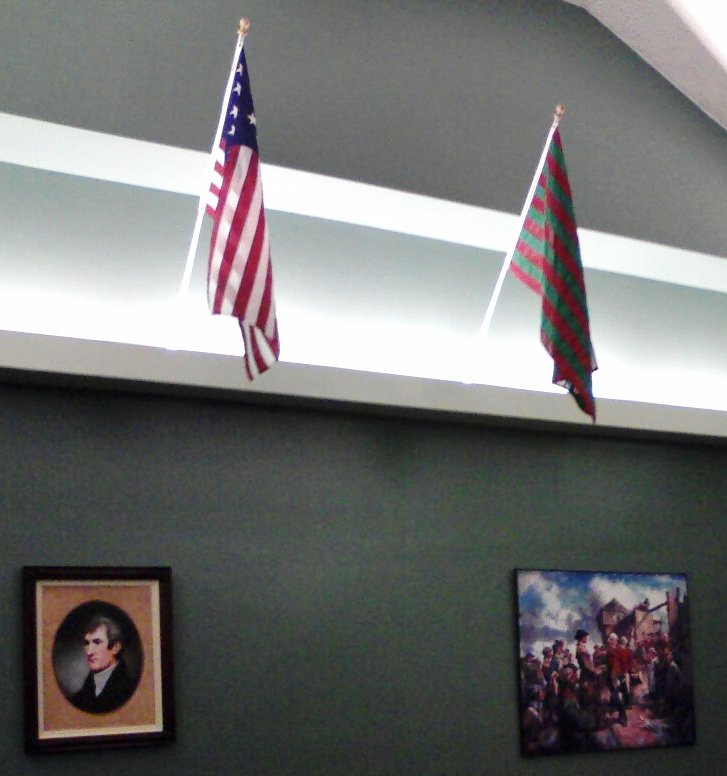George Rogers Clark Flag on:
[Wikipedia]
[Google]
[Amazon]
The George Rogers Clark Flag is a red and green striped banner in the model of

 Of all the flags which may have been used during Clark's
Of all the flags which may have been used during Clark's The Hoosier Patriot
March 2010 Even though Clark, himself, probably never used it, the flag bears his name and is sold by flag retailers as a "George Rogers Clark flag." It is often flown at events in Indiana and Illinois to represent Clark's historic ties with those states. A red and green flag is still flown at the George Rogers Clark National Historic Park, and at the Locust Grove plantation near
National Park Service: George Rogers Clark National Historical Park
of journals by Lt-Gov Henry Hamilton and Capt Bowman, and George Rogers Clark's memoir. Flags of the United States Clark, George Rogers Historical flags Clark, George Rogers Flag
American Flag
The national flag of the United States of America, often referred to as the ''American flag'' or the ''U.S. flag'', consists of thirteen equal horizontal stripes of red (top and bottom) alternating with white, with a blue rectangle in the c ...
s commonly associated with George Rogers Clark
George Rogers Clark (November 19, 1752 – February 13, 1818) was an American surveyor, soldier, and militia officer from Virginia who became the highest-ranking American patriot military officer on the northwestern frontier during the Ame ...
, although Colonel Clark did not campaign under these colors. The "Clark" flag was made in Vincennes, Indiana
Vincennes is a city in and the county seat of Knox County, Indiana, Knox County, Indiana, United States. It is located on the lower Wabash River in the Southwestern Indiana, southwestern part of the state, nearly halfway between Evansville, Indi ...
, and likely flew over Fort Sackville
During the 18th and early 19th centuries, the French, British and U.S. forces built and occupied a number of forts at Vincennes, Indiana. These outposts commanded a strategic position on the Wabash River. The names of the installations were change ...
even before Clark arrived.
Origins
On 12 November 1778, Vincennes resident François Bosseron recorded the following items under the heading "''"1778 fournie au Cap Helm pour les Compagnie des États"''": This flag was designed by Captain Leonard Helm, who held Fort Sackville until forced to surrender to Lieutenant Governor Henry Hamilton. Although historians are not sure exactly what it looked like, most US flags were based on the "stripes of rebellion." Helm's design was clear enough that Hamilton recognized two on his approach to Vincennes, one on a boat and one on the fort. One of these may have been Bosseron's flag, althoughFather Pierre Gibault
Father Pierre Gibault (7 April 1737 – 16 August 1802) was a Jesuit missionary and priest in the Northwest Territory in the 18th century, and an American Patriot during the American Revolution.
Frontier Missionary
Gibault was born 7 April 1737 ...
may have brought a flag with him. Captain Helm had earlier brought a United States flag to Ouiatenon
Ouiatenon ( mia, waayaahtanonki) was a dwelling place of members of the Wea tribe of Native Americans. The name ''Ouiatenon'', also variously given as ''Ouiatanon'', ''Oujatanon'', ''Ouiatano'' or other similar forms, is a French rendering of ...
, so it is possible that he also had brought one to Vincennes. When Hamilton took the fort, he allowed Helm to take down "the continental flag" before raising the British flag.

Colors
The choice of a red and green flag instead of red and white flag remains a mystery. It is possible that there simply was not enough white serge available in Vincennes at the time. It is worth noting, however, that whereas Colonel Clark had offered a red and white belts to American Indians inCahokia
The Cahokia Mounds State Historic Site ( 11 MS 2) is the site of a pre-Columbian Native American city (which existed 1050–1350 CE) directly across the Mississippi River from modern St. Louis, Missouri. This historic park lies in south- ...
to represent war or peace, Captain Helm presented the Wabash Indians with a red or green belts. On December 27 at Vincennes, a Piankeshaw chief presented Lt-Gov Hamilton with red and green wampum
Wampum is a traditional shell bead of the Eastern Woodlands tribes of Native Americans. It includes white shell beads hand-fashioned from the North Atlantic channeled whelk shell and white and purple beads made from the quahog or Western Nort ...
, which was said to represent the Wabash River.
The stripes, themselves, were a defining feature of British American flags even before the Revolution, and many military banners used by Americans featured stripes of differing colors. Records describe flags similar or identical to this in the 13 colonies. It is possible that Busseron ordered the banner for his own militia unit in Vincennes, when they declared for the United States.
George Rogers Clark
Which flag design Clark's men actually marched behind is not known. In his memoir, Clark says he had 10 or 12 sets of colors when they took Vincennes. Some theorize that he probably marched under the flag of Virginia, his home state, but Lt-Gov Henry Hamilton refers to several "American" flags in his journal entries as he leads his expedition down theWabash River
The Wabash River ( French: Ouabache) is a U.S. Geological Survey. National Hydrography Dataset high-resolution flowline dataThe National Map accessed May 13, 2011 river that drains most of the state of Indiana in the United States. It flows fro ...
, including a "rebel flag" he received at Ouiatenon
Ouiatenon ( mia, waayaahtanonki) was a dwelling place of members of the Wea tribe of Native Americans. The name ''Ouiatenon'', also variously given as ''Ouiatanon'', ''Oujatanon'', ''Ouiatano'' or other similar forms, is a French rendering of ...
on 4 December. When Clark arrived in Vincennes on 23 February 1779, he used many banners to give the impression of a large army. Clark's Captain Bowman notes in his journal that an "American flag" was raised over Ft Sackville on 25 February 1778, but does not describe it.
 Of all the flags which may have been used during Clark's
Of all the flags which may have been used during Clark's Illinois campaign
The Illinois campaign, also known as Clark's Northwestern campaign (1778–1779), was a series of events during the American Revolutionary War in which a small force of Virginia militiamen, led by George Rogers Clark, seized control of several B ...
, the 13-striped, red and green banner is the only banner historically documented, and was one of the first "American Flags" flown in the modern State of Indiana
Indiana () is a U.S. state in the Midwestern United States. It is the 38th-largest by area and the 17th-most populous of the 50 States. Its capital and largest city is Indianapolis. Indiana was admitted to the United States as the 19th s ...
. The pattern has been flown by Indiana National Guard
The Indiana National Guard (INNG) is a component of the United States Armed Forces, the United States National Guard and the Military Department of Indiana (MDI). It consists of the Indiana Army National Guard, the Indiana Air National Guard, ...
units deployed to both Iraq and Afghanistan.March 2010 Even though Clark, himself, probably never used it, the flag bears his name and is sold by flag retailers as a "George Rogers Clark flag." It is often flown at events in Indiana and Illinois to represent Clark's historic ties with those states. A red and green flag is still flown at the George Rogers Clark National Historic Park, and at the Locust Grove plantation near
Louisville, Kentucky
Louisville ( , , ) is the largest city in the Commonwealth of Kentucky and the 28th most-populous city in the United States. Louisville is the historical seat and, since 2003, the nominal seat of Jefferson County, on the Indiana border ...
, where George Rogers Clark died.
Notes
Sources
* Barnhart, John D. and Riker, Dorothy L. ''Indiana to 1816. The Colonial Period.'' ©1971, Indiana Historical Society. *Mastai, Boleslaw and Marie-Louise D'Otrange 'The Stars and the Stripes. The American Flag as Art and as History from the Birth of the Republic to the Present' ©1973. Alfred A. Knopf, New York. {{ISBN, 0-394-47217-9 *Shaw, Janet P. (editor) ''Account Book of Francis Bosseron'' Edited by Janet P. Shaw 1929. In the original French and in translation. *Somes, Joseph Henry VandeBurgh. Old Vincennes Graphic Books, New York. 1962. LCCN 62-18417.External links
National Park Service: George Rogers Clark National Historical Park
of journals by Lt-Gov Henry Hamilton and Capt Bowman, and George Rogers Clark's memoir. Flags of the United States Clark, George Rogers Historical flags Clark, George Rogers Flag
George Rogers Clark Flag
The George Rogers Clark Flag is a red and green striped banner in the model of American Flags commonly associated with George Rogers Clark, although Colonel Clark did not campaign under these colors. The "Clark" flag was made in Vincennes, Indiana, ...